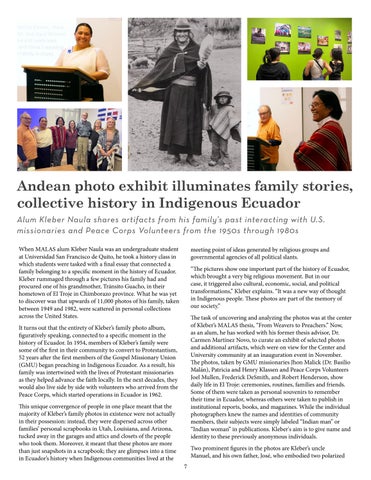Andean photo exhibit illuminates family stories, collective history in Indigenous Ecuador Alum Kleber Naula shares artifacts from his family’s past interacting with U.S. missionaries and Peace Corps Volunteers from the 1950s through 1980s When MALAS alum Kleber Naula was an undergraduate student at Universidad San Francisco de Quito, he took a history class in which students were tasked with a final essay that connected a family belonging to a specific moment in the history of Ecuador. Kleber rummaged through a few pictures his family had and procured one of his grandmother, Tránsito Guacho, in their hometown of El Troje in Chimborazo province. What he was yet to discover was that upwards of 11,000 photos of his family, taken between 1949 and 1982, were scattered in personal collections across the United States.
meeting point of ideas generated by religious groups and governmental agencies of all political slants. “The pictures show one important part of the history of Ecuador, which brought a very big religious movement. But in our case, it triggered also cultural, economic, social, and political transformations,” Kleber explains. “It was a new way of thought in Indigenous people. These photos are part of the memory of our society.” The task of uncovering and analyzing the photos was at the center of Kleber’s MALAS thesis, “From Weavers to Preachers.” Now, as an alum, he has worked with his former thesis advisor, Dr. Carmen Martínez Novo, to curate an exhibit of selected photos and additional artifacts, which were on view for the Center and University community at an inauguration event in November. The photos, taken by GMU missionaries Jhon Malick (Dr. Basilio Malán), Patricia and Henry Klassen and Peace Corps Volunteers Joel Mullen, Frederick DeSmith, and Robert Henderson, show daily life in El Troje: ceremonies, routines, families and friends. Some of them were taken as personal souvenirs to remember their time in Ecuador, whereas others were taken to publish in institutional reports, books, and magazines. While the individual photographers knew the names and identities of community members, their subjects were simply labeled “Indian man” or “Indian woman” in publications. Kleber's aim is to give name and identity to these previously anonymous individuals.
It turns out that the entirety of Kleber’s family photo album, figuratively speaking, connected to a specific moment in the history of Ecuador. In 1954, members of Kleber’s family were some of the first in their community to convert to Protestantism, 52 years after the first members of the Gospel Missionary Union (GMU) began preaching in Indigenous Ecuador. As a result, his family was intertwined with the lives of Protestant missionaries as they helped advance the faith locally. In the next decades, they would also live side by side with volunteers who arrived from the Peace Corps, which started operations in Ecuador in 1962. This unique convergence of people in one place meant that the majority of Kleber’s family photos in existence were not actually in their possession: instead, they were dispersed across other families’ personal scrapbooks in Utah, Louisiana, and Arizona, tucked away in the garages and attics and closets of the people who took them. Moreover, it meant that these photos are more than just snapshots in a scrapbook; they are glimpses into a time in Ecuador’s history when Indigenous communities lived at the
Two prominent figures in the photos are Kleber’s uncle Manuel, and his own father, José, who embodied two polarized 7










